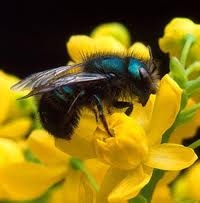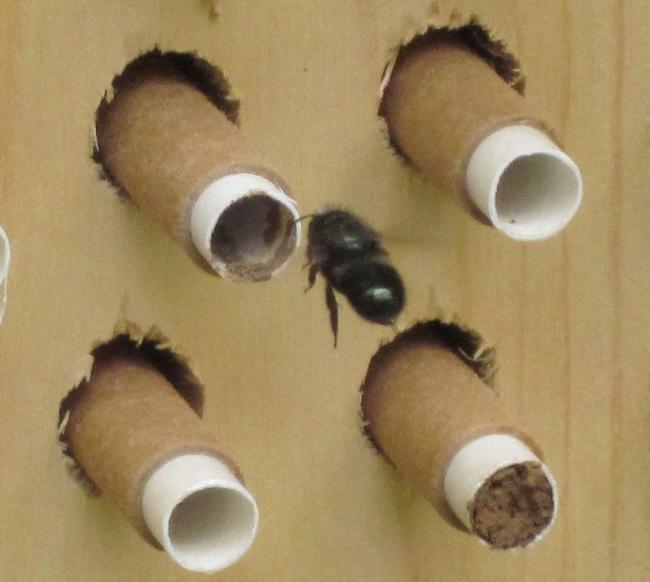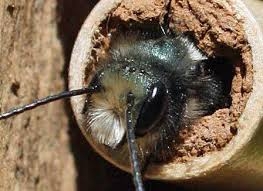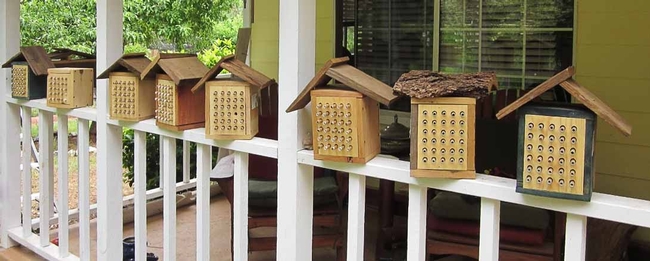By Carol Koenig, Butte County Master Gardener, March 3, 2017.

Mason bees look similar to house flies – they have black bodies and a dark blue iridescent sheen. One advantage for the family backyard is that the males do not have a stinger and the females will only sting if trapped or squeezed.
The mason bee is a solitary bee which lives in natural cavities such as woodpecker holes or hollow stems. They also seem to be just as happy in artificially-constructed nests, so long as these nests include tubes made of cardboard or paper where the female bee can lay her eggs.

Purpose-built nests, often called bee boxes, are set out in early spring when daytime temperatures regularly reach 55 degrees. The bee box is placed outside, facing south in a location that is sunny but protected from wind and rain. Because mason bees will not fly farther than three hundred yards from their nest, bee boxes must be located within range of fruit trees and flowering plants.
The bees emerge from their home in early spring when fruit trees start to bloom. The males emerge first, waiting for the females. When the females come out they quickly mate and start work on their nests for the year. They begin by finding a suitable hole and then start to gather pollen and nectar from nearby trees and plants.
The mason bee gathers pollen on her underside. As she zig-zags among the blossoms she is picking up and dropping off pollen, thus pollinating the flowers as she travels. One mason bee can pollinate 2,000 blossoms in a single day. She brings pollen back to her nest and deposits it at the back of the tube, making a mound on which she will lay one egg. She then seals the space off with mud to create a cell. It is because they use mud in their nest construction that they are called mason bees.
The female mason bee starts another nesting cell and continues until the nesting chamber or tube is filled with a series of egg cells. Amazingly the bee is able to determine, before she lays an egg, whether that egg contains a male or female larva. She will lay female eggs at the rear of the chamber, for protection, and put the male eggs up front. Finally, she seals off the front of the tube with a mud plug.
All this activity can be closely watched since the bees don't sting. The female can be seen heading into her chamber when she is laden with pollen, and backing into her chamber when she is about to lay an egg. Sometimes she just likes to rest in the front of the chamber. This activity continues for six to eight weeks, and then the mother bee dies.
Mason bee larvae hatch a few days after their eggs are laid. The larvae eat the pollen the mother has provided and then each larva goes into a pupal stage. The following spring, the adult bees emerge. The males emerge from the nest first, the females follow, and the process begins all over again.
If you would like to learn more about these bees, local mason beekeeper and Master Gardener Tom Hansen will be speaking about them at Hodge's Nursery in Durham on March 11, at 10 a.m.
More information on mason bees can also be found at Crown Bees
Instructions for building your own bee box can be found at National Wildlife Federation's Garden for Wildlife.
This article is based on information provided by Tom Hansen, local mason beekeeper and Butte County Master Gardener, and a talk on mason bees given by Susan Morrison, Contra Costa Master Gardener, in 2013.




